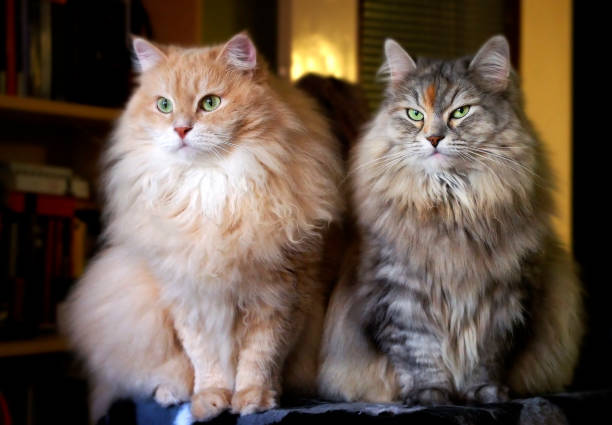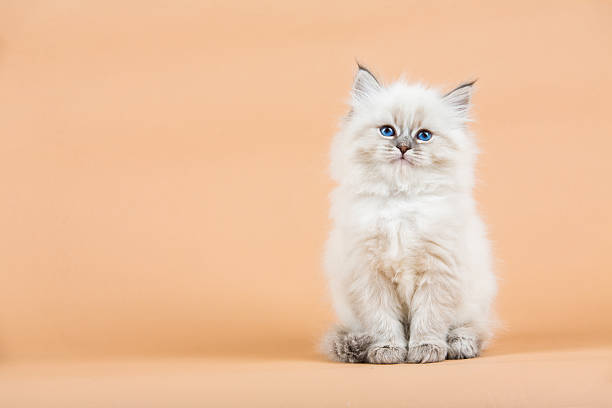Siberian Forest Cat

History:
The Siberian cat is a natural breed with ancient roots in Russia, dating back over a thousand years. These rugged felines evolved in the forests of Siberia, developing thick coats to survive the harsh, cold climate. They were common in Russian folktales and rural farms, known for their hunting ability and loyalty. Though well-known in their homeland, Siberians only gained international attention in the 1990s after the fall of the Soviet Union. The breed was introduced to the United States in 1990 and quickly gained popularity for its beauty, strength, and affectionate personality. Recognised by major cat associations like TICA and CFA, the Siberian is now beloved worldwide for its majestic appearance and warm nature.
Size: Medium to large
Height: 23–28 cm
Weight: 4–9 kg
Life Expectancy: 11 to 18 years

Breed Appearance:
The Siberian cat is a large, muscular breed with a sturdy, well-balanced frame and strong bones. Its head is broad and rounded with full cheeks, a short, slightly concave nose, and large, expressive eyes in shades of green, gold, or blue. Ears are medium-sized, rounded, and often tufted. One of the breed’s most defining features is its luxurious triple coat, which consists of a dense undercoat, soft middle coat, and a water-resistant outer layer. This thick fur forms a full ruff around the neck and breeches on the hind legs, especially prominent in winter. The coat comes in a wide variety of colours and patterns, including tabby, solid, and colourpoint.
Health & Care:
Siberians are generally robust and healthy, though they can be prone to hypertrophic cardiomyopathy (HCM), a common heart condition in cats. Reputable breeders screen for this and other genetic issues. Their dense coat requires regular brushing—two to three times per week—to prevent tangles and mats, especially during seasonal shedding in spring and fall. Otherwise, their grooming needs are manageable. They are active and benefit from daily play and enrichment. Regular vet checkups, a balanced diet, and dental care support their long-term health. Known for their resilience, Siberians adapt well to various climates and lifestyles.

Living Conditions:
Siberians adapt well to both apartments and larger homes, provided they have enough stimulation and companionship. They are agile jumpers and climbers, so vertical spaces like cat trees or shelves help satisfy their instincts. Affectionate and people-oriented, they often follow their humans and enjoy being near family members without being overly demanding. They get along well with children, other cats, and even dogs, making them a good fit for multi-pet households. While they enjoy the outdoors, they should be kept in secure spaces to avoid hazards. Their calm demeanour and adaptability make them excellent indoor companions.
Grooming:
Despite their thick coat, Siberians are not as high-maintenance as they appear. Their fur is less prone to matting due to its texture, but regular brushing, especially during heavy shedding seasons, is essential. A metal comb or slicker brush works best to manage the undercoat and reduce shedding. Routine grooming also includes nail trimming, ear cleaning, and dental care. Bathing is rarely needed, as their coat repels dirt and water naturally. With consistent grooming habits, Siberians remain clean and healthy, and their beautiful coat retains its volume and shine.

Advantages:
-
Siberians are affectionate, loyal, and intelligent cats that bond closely with their families without being overly clingy.
-
They are excellent with children and other pets, making them ideal for multi-pet or family households.
-
Their majestic coat and expressive eyes give them a striking appearance, yet they require only moderate grooming.
-
They are playful, agile, and enjoy interactive toys and games, making them entertaining companions.
-
Siberians are known to be less allergenic than other breeds, producing lower levels of the Fel d 1 protein that causes cat allergies.
Disadvantages:
-
Their thick coat sheds heavily, especially during seasonal changes, requiring frequent brushing to avoid matting.
-
While typically healthy, they can be predisposed to genetic conditions like HCM, necessitating regular veterinary monitoring.
-
They are intelligent and active, which means they need mental and physical stimulation to prevent boredom-related mischief.
-
Their size and agility mean they may jump onto high surfaces or open cabinets, requiring cat-proofing at home.
-
Though hypoallergenic for some, they are not allergy-free and may still trigger reactions in sensitive individuals.

